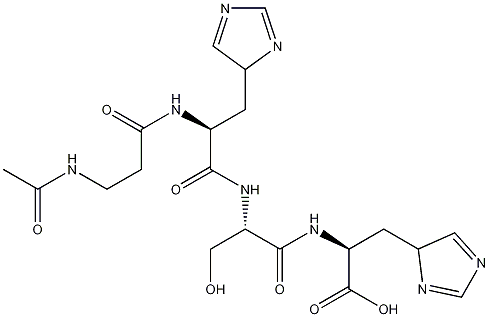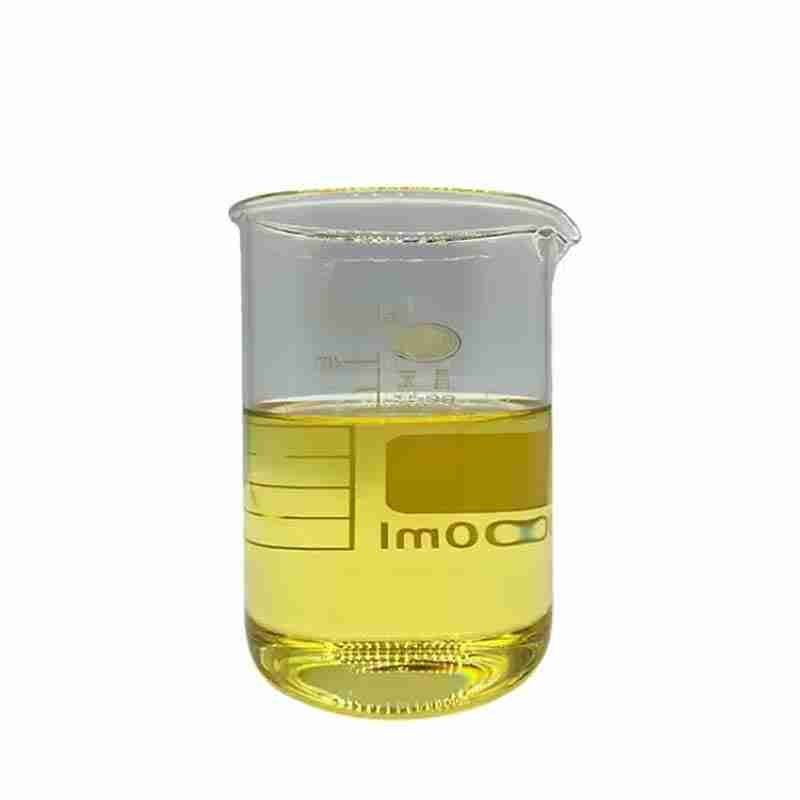Acetyl Tetrapeptide-5 CAS# 820959-17-9
Acetyl Tetrapeptide-5 is a white to cream coloured powder. The active ingredient is used to treat lachrymal sacs and dark circles under the eyes. It stimulates cell metabolism, improves skin elasticity, reduces puffiness and water retention in the eye area and makes the skin supple.Acetyl tetrapeptide-5 inhibits collagen glycation avoiding skin losing elasticity and subsequent eyebags formation .
Acetyl tetrapeptide-5 prevents liquid accumulation in eyebags .
Acetyl tetrapeptide-5 shows a slight lightening effect which decreases dark circles under the eyes Use level: 0.01 %, maximum 0.1 % (water soluble)
发送询盘
Acetyl Tetrapeptide-5 CAS# 820959-17-9
| Acetyl Tetrapeptide-5 Basic information |
| Product Name: | Acetyl Tetrapeptide-5 |
| Synonyms: | N-Acetyl-beta-alanyl-L-histidyl-L-seryl-L-histidine;Acetyl tetrapeptide-5;Acetyl Tetrapeptide;Depuffin/Acetyl Tetrapeptide-5;Acetyl Tetrapeptide-5/eyeseryl;Depuffin;tetrapeptide;Eyeseryl / Acetyl Tetrapeptide-5 |
| CAS: | 820959-17-9 |
| MF: | C20H28N8O7 |
| MW: | 492.49 |
| EINECS: | 1312995-182-4 |
| Product Categories: | BEAUTY PEPTIDES;APIs;820959-17-9 |
| Mol File: | 820959-17-9.mol |
 |
|
| Acetyl Tetrapeptide-5 Chemical Properties |
| Boiling point | 1237.3??65.0 ??C(Predicted) |
| density | 1.443 |
| storage temp. | 2-8??C |
| solubility | PBS (pH 7.2): 10 mg/ml |
| form | A crystalline solid |
| pka | 2.76??0.10(Predicted) |
| color | White to off-white |
| InChIKey | RIUMNDWYYDHBFO-UDJPXWLSNA-N |
| SMILES | C(O)(=O)[C@H](CC1N=CN=C1)NC(=O)[C@H](CO)NC(=O)[C@H](CC1N=CN=C1)NC(=O)CCNC(C)=O |&1:3,13,19,r| |
- 2
- 2-diallylpent-4-en-1-amine
- 4
- 95-16-9
- Ammonium sulfamate
- Benzothiazole
- cas:67889-00-3ح2
- cas:83524-75-8 | pigment black 32
- cas:928836-00-4 | 2
- cas:932745-70-5 | 4
- Chemical Minerals
- Coconut diethanolamide
- Daily Chemicals
- discount
- for sale
- General pvc resin
- hexyl D-glucoside
- in stock
- Lauramidopropyl betaine
- LAURIC ACID MONOETHANOLAMIDE
- Petroleum Additives
- Plasticiser
- Ploymers
- price
- PVC
- quotation
- Raw Materal
- Remove term: Petroleum Additives Petroleum Additive
- SODIUM ETHYL 2-SULFOLAURATE
Related Products
Chemical Name: Choline salicylate
CAS No.: 2016-36-6
Molecular Formula: C12H19NO4
Molecular Weight: 241.28
Appearance: Red-Brown Crystal
Silicone oil, known for its chemical designation as dimethicone or polydimethylsiloxane, is a synthetic polymer with a backbone of alternating silicon and oxygen atoms, creating a highly versatile and stable compound. It is renowned for its exceptional lubricating properties, heat resistance, and non-toxic nature, making it a staple in various industries, including cosmetics, automotive, and aerospace.
This hydrophobic, non-volatile oil is valued for its ability to provide a smooth, non-greasy feel and to form stable emulsions with other ingredients. In personal care products, silicone oil is used to impart a silky texture, reduce friction on the skin, and create a protective barrier against environmental stressors without clogging pores.
Silicone oil’s chemical inertness and resistance to oxidation contribute to its long shelf life and stability in formulations. It is also appreciated for its compatibility with a wide range of substances, allowing for the creation of multifunctional products.
In summary, silicone oil is a reliable and multifaceted ingredient, offering a combination of performance, safety, and sensory benefits. Its use in a variety of applications reflects its versatility and enduring appeal in the marketplace.
N,N-Dimethylaniline is an organic compound with amine and methyl groups attached to a benzene ring. It is a colorless liquid with a characteristic amine odor. This compound is primarily used as a chemical intermediate in the synthesis of dyes, pigments, and polymers. Its reactivity makes it a valuable building block in the production of various organic compounds, particularly in the pharmaceutical and chemical industries.
Chemical Name: Quercetin-3-O-sophoroside
CAS No.: 18609-17-1
Molecular Formula: C27H30O17
Molecular Weight: 626.52
Product name:Cyclopentane
Purity:96%
Appearance:White powder
Package:25kg/bag
Sample:Available
Common English name: 5-iodo-2,3-dihydropyridazin-3-one
CAS No.: 825633-94-1
Molecular formula: C4H3IN2O
Molecular weight: 221.98
Sample: Available
3,4-Ethylenedioxythiophene is a synthetic organic compound characterized by its unique structure that includes a thiophene ring with ethylenedioxy substituents at the 3 and 4 positions. This compound is known for its potential applications in the synthesis of various organic materials, including pharmaceuticals and organic electronic devices such as sensors and solar cells. Its stability and reactivity make it a versatile intermediate in the chemical industry.
Chemical Name: 3-Hydroxybutyric acid
CAS No.: 625-71-8
Molecular Formula: C4H8O3
Molecular Weight: 104.1
Appearance: White powder
Butylated Hydroxytoluene (BHT) is a synthetic phenolic antioxidant commonly added to foods, cosmetics, and packaging to prevent the oxidation of fats and oils, thereby extending their shelf life. It is also used as a preservative in a variety of products, including rubber, petroleum products, and animal feed. BHT is recognized for its effectiveness in maintaining nutrient levels, color, flavor, and odor in food products . It is known to have a melting point of 69-71??C, a boiling point of 265??C, and is soluble in ethanol, acetone, and benzene, but not in water, glycerin, or propylene glycol . BHT is also used in some dietary supplements due to its antioxidant properties . However, it is important to handle BHT with care, as it can cause skin irritation and is considered harmful if swallowed .
Ethylhexyl Palmitate is a skin-conditioning ester, derived from ethylhexanol and palmitic acid, that imparts moisturization and a smooth texture to cosmetic and personal care formulations. It is valued for its emollient properties, enhancing the sensory experience of skin care products.
Octocrylene is an organic compound widely recognized for its potent UV-filtering properties, making it an essential ingredient in sunscreens and other skincare products designed to protect the skin from harmful ultraviolet radiation. With the chemical name 2-(4-Methylbenzyl)-2H-benzotriazole-5-methyl, octocrylene is a stable and photostable molecule that provides broad-spectrum protection against both UVA and UVB rays.
This oil-soluble chemical is valued for its ability to absorb UV radiation effectively, converting it into heat without causing skin irritation or staining clothes. Octocrylene is often used in combination with other UV filters to enhance the sun protection factor (SPF) of formulations, ensuring a balanced and comprehensive defense against sun damage.
As a lipophilic compound, octocrylene is compatible with various cosmetic and dermatological formulations, contributing to the development of lightweight, non-greasy sunscreens. Its chemical structure allows for a high degree of safety and efficacy, making it suitable for a wide range of skin types, including sensitive skin.
In summary, octocrylene is a reliable and efficient UV filter, pivotal in the formulation of modern sunscreens that offer advanced protection against the sun’s harmful effects while maintaining skin comfort and product aesthetics.
Chemical Name: Arabic gum
CAS No.: 9000-01-5
Appearance: powder



















